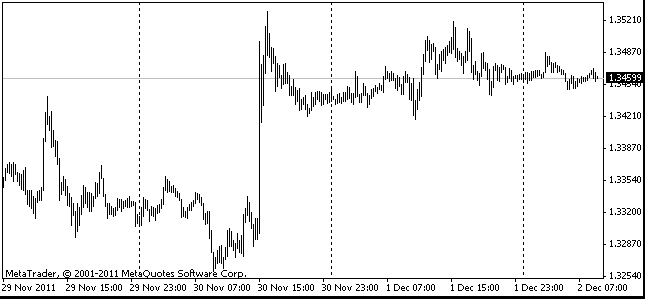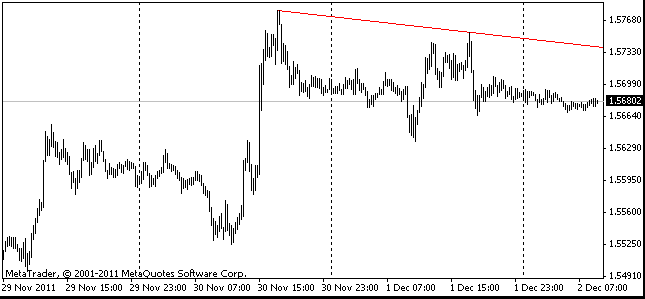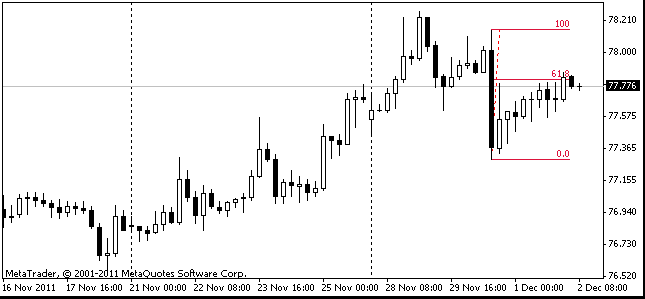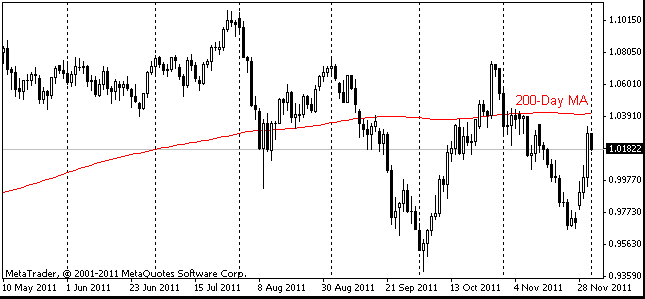EUR/usd
On Monday the euro fell below 1.32 due to the investors' disappointment in the EU summit. Problems haven't been solved; all we have now are just pledges to consider a closer fiscal union in half a year – an eternity for a debt crisis! eurusd is now at 1.3170. It was at 1.3370 at the beginning of Monday's trading. Moreover, the received comments have once again proved that Germany is not very willing to accept current terms. The fact is that Bundesbank can issue a loan to the IMF only when given the consent of legislators. As follows from the previous experience it is likely to turn into a few months of sitting on a powder keg with booming fireworks around. Apart from this we should also take into consideration the seasonal factors that Bernanke and Co. tried to combat a couple of weeks ago. By the end of the year the demand for liquid assets usually goes up. Now such assets are the dollar and to a lesser extent the yen. The fact that the observed movement is heading for the liquidity and not for the safety is proved by a vigorous sale of gold. It fell in price by $50 to $1660 per ounce. EURUSD has broken the support line we spoke about yesterday. This can give rise to a strong wave of sales in the coming days. Well, Europeans themselves are to blame for such an outcome. Can this be a clever trick with competitive devaluation? Certainly it can't as the current situation is freezing debt markets and paralyzing business processes.

GBP/USD
sterling feels a bit better than the troubled euro, but essentially has no strength to resist the power of risky asset sales on the flight from European currencies to the dollar. Having been stuck to the level of 1.5630 for a considerate period of time, on Monday the pair at last started off and eventually descended to 1.5540. Lately it has bounced up and is now trading at 1.5590. On Tuesday we will be able to see how far the process of disinflation in Britain has gone. According to the average market forecast the annual inflation rate will go down from 5.0% to 4.7%. Some predict that the inflation slowdown will be sharper because of retailers' efforts to increase sales by means of discounts. Actually a sharp slowdown will free the BOE's hands in expanding of the QE programme. Now its size is 275 billion, almost 245 billion of which are already on the balance sheet. If the current pace is kept, the programme will have been implemented by February, but many are now expecting its extension. Some investment banks estimate the total amount of QE at 350-400 billion. All these factors are potentially negative for sterling against the dollar. But thanks to the fact that the British government announced enforcing of economy measures earlier and more successfully, the markets have more confidence in this country thus supporting the descending of EURGBP.

USD/JPY
The dynamics of the pair meets our expectations, at least for now. The yen is falling against the dollar on the wave of buying of the U.S. currency. On Monday the pair rose from 77.60 to 78.0. Of course, such strengthening can hardly be called significant, but for the half-dead yen it is a real progress. It is noteworthy that the pair is trading just in the same area where it had consolidation after the intervention on the last day of October. These levels must be to the MoF's liking, but (and there is always a “but”!) at the same time we can observe a decrease in other crosses, which are also very important for the country's trading position. The latter actually ruins the entire picture. EURJPY is trading at 102.70. It is only two big figures from the 10-year minimum. Trading with the euro area is as important for Japan as trading with the US. Is this time for Japan to come to Europe's rescue and buy debt securities of the region thus helping out debt markets and supporting the single currency rate? Fortunately, Japan has enough reserves for that – $ 1.3 trillion and in November they increased it by $ 100 billion due to that very intervention. Can't it be the right time to carry out interventions with the euro?

AUD/USD
Australian dollar has surrendered to bears. Bulls have backed off for some time as they are not strong enough to resist the growth of the USD and the sale of metals. As has already been mentioned, on Monday the capital flowed not only from the euro, but also from gold. This precious metal and aussie are in close correlation with each other. In addition, on Monday the Australian currency was affected by the weak data on trade balance (surplus fell sharply from $2.25b to $1.6b). Today unfavourable data keep coming out. The number of Australian housing starts has been decreasing for 2 months in a row with an impressive decline of 6.8% after falling by 4.1% a month earlier. audusd is currently trading at 1.005. The next goal – parity – will whittle the entire growth caused by the coordinated actions of major central banks.
